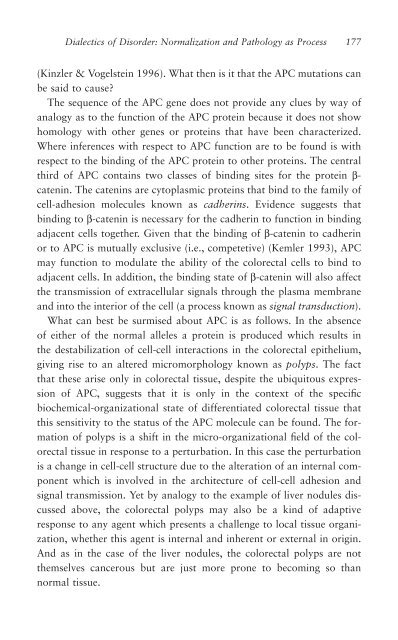A Critique of Pure (Genetic) Information
A Critique of Pure (Genetic) Information
A Critique of Pure (Genetic) Information
You also want an ePaper? Increase the reach of your titles
YUMPU automatically turns print PDFs into web optimized ePapers that Google loves.
Dialectics <strong>of</strong> Disorder: Normalization and Pathology as Process 177<br />
(Kinzler & Vogelstein 1996). What then is it that the APC mutations can<br />
be said to cause?<br />
The sequence <strong>of</strong> the APC gene does not provide any clues by way <strong>of</strong><br />
analogy as to the function <strong>of</strong> the APC protein because it does not show<br />
homology with other genes or proteins that have been characterized.<br />
Where inferences with respect to APC function are to be found is with<br />
respect to the binding <strong>of</strong> the APC protein to other proteins. The central<br />
third <strong>of</strong> APC contains two classes <strong>of</strong> binding sites for the protein bcatenin.<br />
The catenins are cytoplasmic proteins that bind to the family <strong>of</strong><br />
cell-adhesion molecules known as cadherins. Evidence suggests that<br />
binding to b-catenin is necessary for the cadherin to function in binding<br />
adjacent cells together. Given that the binding <strong>of</strong> b-catenin to cadherin<br />
or to APC is mutually exclusive (i.e., competetive) (Kemler 1993), APC<br />
may function to modulate the ability <strong>of</strong> the colorectal cells to bind to<br />
adjacent cells. In addition, the binding state <strong>of</strong> b-catenin will also affect<br />
the transmission <strong>of</strong> extracellular signals through the plasma membrane<br />
and into the interior <strong>of</strong> the cell (a process known as signal transduction).<br />
What can best be surmised about APC is as follows. In the absence<br />
<strong>of</strong> either <strong>of</strong> the normal alleles a protein is produced which results in<br />
the destabilization <strong>of</strong> cell-cell interactions in the colorectal epithelium,<br />
giving rise to an altered micromorphology known as polyps. The fact<br />
that these arise only in colorectal tissue, despite the ubiquitous expression<br />
<strong>of</strong> APC, suggests that it is only in the context <strong>of</strong> the specific<br />
biochemical-organizational state <strong>of</strong> differentiated colorectal tissue that<br />
this sensitivity to the status <strong>of</strong> the APC molecule can be found. The formation<br />
<strong>of</strong> polyps is a shift in the micro-organizational field <strong>of</strong> the colorectal<br />
tissue in response to a perturbation. In this case the perturbation<br />
is a change in cell-cell structure due to the alteration <strong>of</strong> an internal component<br />
which is involved in the architecture <strong>of</strong> cell-cell adhesion and<br />
signal transmission. Yet by analogy to the example <strong>of</strong> liver nodules discussed<br />
above, the colorectal polyps may also be a kind <strong>of</strong> adaptive<br />
response to any agent which presents a challenge to local tissue organization,<br />
whether this agent is internal and inherent or external in origin.<br />
And as in the case <strong>of</strong> the liver nodules, the colorectal polyps are not<br />
themselves cancerous but are just more prone to becoming so than<br />
normal tissue.
















